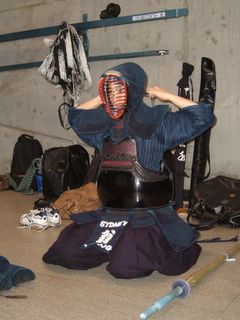忍耐 + 掌握人生
Sucker!
Today's warm-up and technique sessions were vastly different to the other training sessions. We practiced the really basic kihon cuts against 4 motodachi (Itakura sensei, Mike Henstock, Andrew van Hamond and Doug) for 1 hour without putting our men and kote bogu on.
It was during the warm-up session that I noticed this new Japanese, who turned out to be Kitagawa sensei, performed those fluent big kihon cuts. His cuts were like unstoppable waves powering forward. It's just so nice to watch. I was very lucky to be able to play against him in the wasa and jigeiko session afterwards.
Bring my Brain
I was a sucker today playing Sano sensei in jigeiko. I was like a stupid fish going for the bait again and again. Sano sensei deliberately opened his kote and I just kept falling into his kote trap. I didn't know how many kote-nuki-men Sano sensei has succeeded. I should have known better after a few kote-nuki-men from Sano sensei to not go for the kote bait. Bottom line of this story - Bring my brain to jigeiko.
Maintain Kensen in the Centre
One thing I did concentrate on today was seme - breaking the opponent's centre. I tried knocking Sano sensei's shinai out of the centre and then cut his men. But each time I knocked sensei's shinai off centre and was ready to launch a men cut, Sano sensei's shinai would be back into centre once again to block my men cut. I was pretty confused as to what I was doing wrong. Then Sano sensei pointed out that my own kensen was off centre too after I knocked his shinai off centre. The time for me to re-adjust my kensen and launched a cut gave my opponent's enough time to recover and block my cut. What I should aim for was to maintain my kensen pointing to my opponent's throat at all time.
Forward. Forward.
I also had a chance to play Itakura sensei just before the training finished. Itakura sensei pointed out that I was steping side-way after rising from sonkyu. That's a big NO NO. It showed weakness in my kendo. Always moved forward.
Other things Itakura sensei pointed out today were my hip wasn't pushing forward enough (aiya! Not again!) and my arms were raised too high after my men cut. I should maintain my arms at shoulder level when passing through after the men cut.
Main things I should focus on next session:
- Hip forward.
- Seme. Maintain kensen to the centre.


 Name: Vivian Yung
Name: Vivian Yung